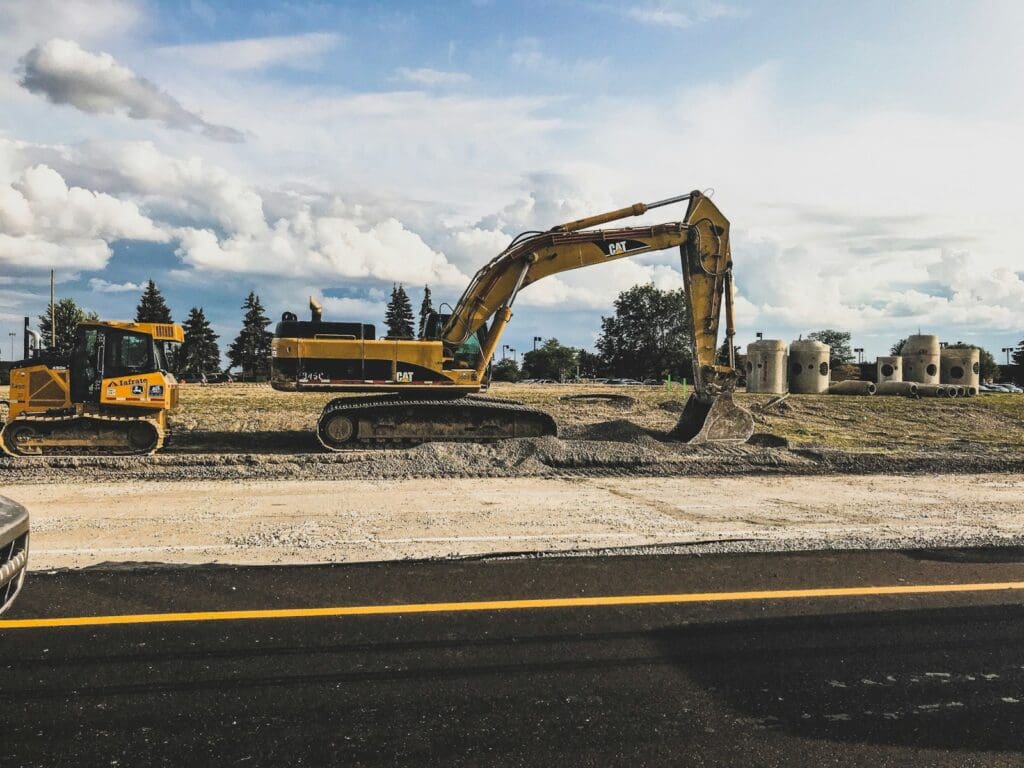Extensions of Time (EOTs) allow the contractual completion date to be adjusted when the Contractor experiences qualifying delays beyond their control. EOTs protect against liquidated damages and formalise project timeline changes through defined procedures.
Key Takeaways
- EOTs extend the contractual completion date for delays outside the Contractor’s control
- Strict notice and substantiation requirements apply across most standard contracts
- Principals must administer EOTs fairly to avoid invoking the prevention principle
- AS 4000, AS 2124, GC21, MBA and Defence contracts all differ in how EOTs are handled
- Poorly managed EOT processes are a common cause of formal delay disputes.

Introduction to Construction Delays and Extensions of Time (EOTs)
Construction projects are frequently impacted by delay events, and contracts must account for these scenarios to avoid disputes. Extensions of Time (EOTs) are the legal mechanism by which a Contractor can request additional time to complete the works when certain delays occur. These delays may arise from the Principal’s conduct, latent conditions, weather events, or other circumstances beyond the Contractor’s reasonable control.
An EOT protects the Contractor from liability for liquidated damages where they are not responsible for the delay. At the same time, it allows Principals to formally assess and document changes to the project timeline, ensuring contractual certainty. The EOT process involves notice, evidence, assessment and potential cost consequences, depending on the cause of delay and the contract terms.
Read more about Understanding Extension of Time (EOT) Claims in Australia
What Are Extensions of Time?
An Extension of Time is not simply a recognition that a project is running late. It is a formal contractual adjustment that changes the Date for Practical Completion because of an accepted delay event. The mechanism applies only when a qualifying event occurs—usually defined by the contract—and the Contractor complies with the notice and substantiation requirements. Without an EOT, even an excusable delay may result in a breach or exposure to liquidated damages.
EOTs are designed to ensure that risk is allocated fairly and that project timelines are realistic as circumstances evolve. The process also encourages both parties to engage in proactive contract administration, rather than managing delays informally or through inconsistent instructions.
When Is a Contractor Entitled to an EOT?
A Contractor becomes entitled to an Extension of Time when a delay occurs due to an event listed in the contract as a valid ground for extension, and they can prove that the delay has impacted the critical path. This typically includes events like variations, Principal-caused delays, inclement weather, industrial disputes, site access issues, or latent site conditions.
However, entitlement is not automatic. The Contractor must follow the EOT procedure set out in the contract, which usually includes timely written notice and a formal submission of a claim that includes supporting evidence. Contracts differ in how strictly these requirements are enforced, but in most cases, failure to meet the process will extinguish the claim.
The Importance of Timely EOT Notice
Timely notice is a cornerstone of any EOT claim. Most construction contracts, including AS 4000 and GC21, include strict timeframes for giving notice of delay. These range from 5 to 28 days, depending on the contract, and are typically measured from the time the Contractor becomes aware—or ought to become aware—of the delay.
Failure to give notice within this period may result in:
- Loss of entitlement to an extension
- Exposure to liquidated damages
- Disputes over whether the delay could have been mitigated
Contractors must ensure they understand the timing requirements in their specific contract and implement internal processes to track and respond to delay events as they occur.
Substantiating an Extension of Time Claim
An EOT claim must be supported by clear evidence. Simply stating that a delay occurred is not enough. Contracts require the Contractor to demonstrate that:
- The delay event occurred
- The event was outside their control
- The delay affected the critical path
- The duration of the delay is quantifiable
Common forms of substantiation include updated programs showing the critical path change, weather records, instructions from the Principal, daily site diaries, and correspondence with suppliers or Subcontractors. The quality of evidence often determines whether a claim is approved or rejected.
Understanding Time-Only vs Time-and-Cost EOTs
Some delay events entitle the Contractor to more than just time. If the delay is caused by the Principal, such as failure to provide access or approval delays, the Contractor may be entitled to both an extension of time and delay-related costs. However, neutral events—such as weather or latent conditions—generally entitle the Contractor to time only, not compensation.
This distinction is critical when preparing claims. Contractors should be careful not to conflate time entitlement with cost entitlement. The two must often be claimed separately, even if they arise from the same delay event.
EOT Provisions Under Different Standard Form Contracts
AS 4000
AS 4000 is widely used in commercial construction in Australia and provides a detailed process for managing EOTs under Clause 34. The Contractor must notify the Superintendent within 28 days of becoming aware of a qualifying delay. The Superintendent must then assess the claim and grant an extension if warranted. Clause 34.10 also allows the Superintendent to grant an EOT even if the Contractor has not claimed one, preserving flexibility and fairness.
AS 4000 requires the Contractor to show how the delay affects the critical path and provide appropriate substantiation. If the Superintendent fails to respond within the timeframe, the claim is not automatically accepted—this differs from some other forms of contract.
AS 2124
AS 2124 contains similar provisions to AS 4000 but uses different language and shorter timeframes. Under Clause 35.5, the Contractor must notify delays “as soon as practicable” and follow up with a written claim within 14 days. The clause also provides for delay costs in specific circumstances and requires detailed information to support the claim.
AS 2124 places a greater emphasis on the need for prompt communication and thorough substantiation. It is considered more prescriptive than AS 4000 in some respects and more permissive in others, depending on how “excepted risks” are defined in the contract annexures.
GC21 and Government EOT Procedures
The GC21 contract, commonly used in New South Wales Government projects, imposes stricter notice periods and a two-step claim process. The Contractor must provide an initial notice within 5 business days of becoming aware of the delay and then submit a fully detailed claim within 10 business days.
GC21 promotes collaborative project management. It encourages early dialogue between the Contractor and Principal and provides a mechanism for resolving delay disputes before they escalate. GC21 also explicitly distinguishes between delay events that attract time only and those that entitle the Contractor to delay costs.
MBA Contracts
The Master Builders Australia (MBA) contracts are often used in residential and mid-tier commercial projects. They include provisions for EOTs due to wet weather, variations, and other uncontrollable events. However, the ability to claim delay costs is typically limited to Principal-caused delays. The documentation and procedural requirements are generally less onerous than AS contracts but must still be followed carefully to preserve entitlement.
Defence Contracts
Extension of Time clauses in Defence contracts such as HC-1 (Head Contract) are quite formal and detailed. EOT claims must be made using specific templates, and notice periods are strictly enforced.
Defence contracts often exclude delay costs for neutral events and require a very high standard of record keeping and substantiation.
The Role of the Superintendent in EOT Assessment
In most contracts, the Superintendent is responsible for assessing EOT claims and determining whether they are valid. The Superintendent must act fairly and in accordance with the contract. In AS 4000, the Superintendent is expected to be impartial, even though appointed by the Principal. This expectation brings their dual roles – as impartial assessor vs Principal’s Representative, to the fore.
A failure by the Superintendent to respond to a valid EOT claim or to consider it properly can give rise to disputes or trigger legal principles that prevent the Principal from enforcing liquidated damages. For this reason, the Superintendent must be experienced in delay analysis and understand their duties clearly.
Concurrent Delay and Its Effect on EOT Entitlement
Concurrent delay arises when both the Principal and the Contractor contribute to a delay that affects the critical path. Most contracts are silent on how this should be dealt with, leaving the issue to be resolved through common law or expert evidence.
Generally, if a Contractor is partly responsible for a delay, they may be entitled to a time extension but not delay costs. This can create practical challenges when preparing claims and responding to assessments, especially where delays overlap or sequencing is disputed.
The Prevention Principle
The prevention principle is a common law doctrine that applies when the Principal causes delay and fails to grant an EOT. In such cases, they may be prevented from enforcing liquidated damages because they have interfered with the Contractor’s ability to complete the works on time.
To avoid triggering the prevention principle, Principals must ensure that their EOT provisions operate effectively and that valid claims are not ignored. If the contract lacks a proper EOT clause, the Principal may lose the benefit of time-related enforcement mechanisms altogether.
Advice For Principals
Principals must ensure that their contracts have clear and enforceable EOT clauses and that project administrators understand how to manage them. They should require prompt notification, monitor delay claims, and verify that Superintendents respond within contractual timeframes. Principals who fail to act on valid claims risk creating legal exposure or undermining the effectiveness of their liquidated damages regime.
Advice For Contractors
Contractors should treat EOT procedures as essential project controls. They must implement internal systems for identifying, documenting, and reporting delay events. Early engagement with the Superintendent and prompt submission of claims supported by updated programs and contemporaneous records will increase the likelihood of success and avoid unnecessary disputes.
Conclusion
Extensions of Time are a core feature of modern construction contracts. They allow projects to remain legally and commercially coherent when delays occur. Contractors must comply with notice and substantiation obligations, while Principals and Superintendents must administer EOTs with consistency and fairness. When used as intended, EOT clauses protect both parties, maintain transparency, and ensure accountability throughout the life of the project.

FAQs
1. What are Extensions of Time in construction contracts?
Extensions of Time in construction contracts are formal adjustments to the completion date when delays outside the Contractor’s control occur. They protect Contractors from liquidated damages and preserve contractual timelines.
2. When is a Contractor entitled to an EOT?
A Contractor is entitled to an EOT when a delay event listed in the contract occurs and they can prove it affects the critical path. Timely notice and evidence are required for a valid claim.
3. What are common causes of EOTs?
Common causes of EOTs include Principal delays, variations, inclement weather, industrial action, latent conditions, and failure to provide site access. Contracts specify which events qualify.
4. Do EOTs always include delay costs?
EOTs do not always include delay costs. Time-only relief is common for weather and neutral events, while Principal-caused delays may justify both time and cost compensation.
5. What happens if a Contractor doesn’t notify a delay on time?
If a Contractor doesn’t notify a delay on time, they may lose their entitlement to an EOT and become liable for liquidated damages. Strict notice periods apply in most contracts.
6. What’s the difference between AS4000 and AS2124 EOT clauses?
AS 4000 gives 28 days for notice and allows discretionary EOTs by the Superintendent. AS 2124 requires notice “as soon as practicable” and follows with a detailed claim within 14 days. However, the main difference lies in how the Qualifying Cause of Delay is treated. In AS4000, it encompasses all delays except those listed. In AS2124, it covers the listed delays only.
7. How does GC21 handle EOTs differently?
GC21 requires two-stage notice within 5 and 10 business days and promotes collaborative delay management. It offers time-only or time-and-cost EOTs depending on the delay type.
8. Can Subcontractors claim EOTs directly under the Head Contract?
Subcontractors cannot claim EOTs under the Head Contract. They must claim under their subcontract, and the Head Contractor may include their delay in a broader project claim.
9. What is the Prevention Principle?
The Prevention Principle prevents the Principal from enforcing liquidated damages if they caused a delay and failed to allow a valid EOT. It ensures fairness in contract enforcement.
10. How should Contractors substantiate EOT claims?
Contractors should substantiate EOT claims using updated programs, site diaries, correspondence, delay impact analyses, and relevant instructions or approvals. Documentation is critical.
11. Can an EOT be granted without a formal claim?
Some contracts, like AS 4000, allow the Superintendent to grant an EOT even if the Contractor has not claimed one. This helps preserve fairness where process is missed in good faith.
12. What if the contract doesn’t include an EOT clause?
If the contract doesn’t include an EOT clause, delay relief must be sought under common law. The prevention principle may apply, but risk and recovery become more uncertain.
13. Are liquidated damages still enforceable after an EOT?
Liquidated damages are only enforceable after an EOT if the Contractor fails to reach the adjusted completion date. Valid EOTs extend the timeline and shield the Contractor from damages until the new Date for Practical Completion is reached without the Works being complete.

Relevant Articles
- Construction Law
- Construction Lawyer
- Construction Lawyer Brisbane
- Construction Lawyers Brisbane
- Construction Contract Review
- The Ultimate Guide to Construction and Contracting
- Indemnities, Insurances, and Limits of Liability in Construction Contracts
- Construction Contracts
- Construction Lawyers
- Construction Contract Management
- Construction Contract Administration
- Construction Contract Disputes
- Brisbane Construction Industry
- Construction Industry
- Construction Finance
- Negotiating Changes to a Signed Construction Contract
- Understanding Your Construction Contract
- Project Delivery Methods
- Risk Management in Construction Contracts
- Escalation Clauses
- Construct-Only Contract
- Liquidated Damages in Construction Contracts
- AS 4000-1997 Guide for Contractors
- AS 4000-1997 Guide for Principals
- Guide to AS2124-1994 – Australian Standard Conditions of Contract for Construct Only Projects
- Construction Contract Law
- Construction Contract Liquidated Damages
- Types of Construction Contracts
- Your Design and Construct Contract Explained
- Design and Construct vs Construct-Only
- Dealing with Construction and Building Materials in Your Contract
- Fixed Price Building Contract
- Latent Conditions: Dealing With a Latent Condition at a Construction Site
- DLP Meaning – What is the Defects Liability Period in Construction Contracts?
- Construction Contract Termination
- Construction Contract Templates
- Is a Cyclone a Force Majeure Event in a Construction Contract?
- Construction Contract Variations
- Teaming Agreement
- Strategies for Cost Control in Construction
- Guide to Construction Contracts in Australia
- Practical Guide to Your Building Contract
- Building Contract Law: Tips for Builders and Principals
- Security in Construction Contracts: Bank Guarantees and Retention Moneys
- Time Cost Quality: Mastering the Project Management Triangle







